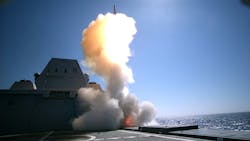Lockheed Martin moves head with placing hypersonic missiles aboard Navy Zumwalt-class land-attack destroyers
WASHINGTON – U.S. Navy surface warship experts are asking engineers at Lockheed Martin Corp. to start integrating future hypersonic missiles aboard the Navy's three stealthy Zumwalt-class (DDG 1000) destroyers.
Officials of the Navy Strategic Systems Programs in Washington announced a $22.8 million contract this week to the Lockheed Martin Space Systems segment in Littleton, Colo., for missile production long-lead materials, program management, and system engineering for the Navy Conventional Prompt Strike Weapon System Platform-Specific Development and Production project.
Lockheed Martin will integrate hypersonic weapons aboard the destroyers USS Zumwalt (DDG 1000), the USS Michael Monsoor (DDG 1001), and the USS Lyndon B. Johnson (DDG 1002). Long-lead items are difficult and time-consuming to obtain, and are funded early in the design process to keep overall production on schedule. Contracts to build Conventional Prompt Strike weapons will come later.
The three Zumwalt-class destroyers are multi-mission stealth ships that focus on land attack, with secondary roles of surface warfare, anti-aircraft warfare, and naval gunfire support. The label destroyer is somewhat of a misnomer because the Zumwalt-class vessels are about the size of small World War II battleships.
Installing hypersonic weapons aboard these three vessels is part of the Navy's Conventional Prompt Strike project to launch attacks against targets around the world in less than an hour. The focus is on attacking high-value, or fleeting targets, with extremely fast hypersonic weapons, which can fly faster than five times the speed of sound.
Lockheed Martin will focus on systems architecture; subsystem, component, and test requirements; design analysis, and design integration; system integration, verification, and validation testing to support initial operating capability.
Related: The emerging world of hypersonic weapons technology
Other areas of the project seek to increase today's industrial base capability for Navy and Army long-range hypersonic weapons; build ready-to-fire hypersonic weapons with diameters larger than 30 inches. This would consist of an encapsulated missile with a hypersonic glide body provided as government furnished equipment; and canister to support the Navy Zumwalt-class ship and future Army weapon systems.
The project will build an advanced payload module with weapons in a three-pack configuration, with interfaces between the ship and the weapons, with support structure, protection, compressed-air ejectors, and environmental control to support the Zumwalt-class destroyer.
On this contract Lockheed Martin will do the work in Littleton, Colo., and should be finished by May 2022. For more information contact Lockheed Martin Space Systems online at www.lockheedmartin.com, or the Navy Strategic Systems Programs office at www.ssp.navy.mil.
